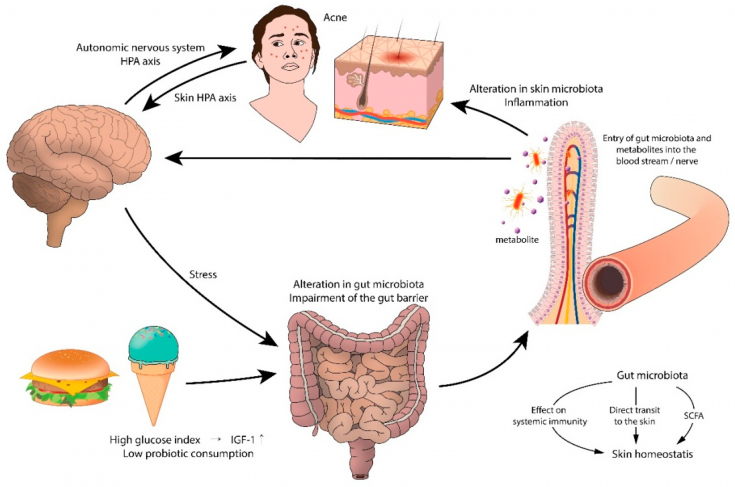Of the trillion microorganisms that inhabit our skin, more than 1000 different species are bacteria, up to 80 species – on fungi, various viruses and even mites also inhabit the skin.
Subcutaneous lymphoid tissue – extremely active structure. In fact, every square centimeter of skin contains over a million symbiont bacteria and the same number of lymphocytes. Thus, the ratio of bacteria and lymphocytes is 1:1.
While the skin microbiome is relatively stable (despite environmental changes), it varies according to ecological niche, or habitat. For example, colonies of microorganisms change depending on the amount of light, pH level, humidity, hairiness and oiliness of the skin. The microbiome also varies by age and gender.
The skin microbiome: a well-balanced defense system
Previously, it was believed that the skin microbiome exists only on its surface, and the deep layers of the dermis are sterile. However, in 2013, scientists refuted this by "digging" deep into the skin looking for microbes. It turned out that microorganisms are present in all layers of the skin, up to the subcutaneous fatty tissue. And host cells are exposed to these microorganisms.
A healthy microbiome protects skin from infections by inhibiting the growth of pathogens.
Skin and intestines are inhabited by certain identical types of microorganisms (firmicutes and bacteroids are found in both locations) and their species, incl. staphylococcus aureus, streptococcus, and candida (although the latter are thought to be present only in cases of skin infections). Some bifidobacteria were found in the stratum corneum, and lactobacilli are more common in the skin of women.
A healthy skin microbiome protects the skin from infections by resisting colonization (i.e., overgrowth of pathogenic organisms) and maintaining a relatively acidic environment (pH around 5.0), which helps to inhibit the growth of pathogens. Staphylococcus epidermidis – symbiont bacterium – produces phenol-soluble modulins that suppress pathogens S.aureus and group A streptococci. Symbiont bacteria also suppress inflammation and stimulate the production of antimicrobial peptides such as cathelicidin which kills bacteria, fungi and viruses.

Skin microbiome:
- promotes healing of lesions;
- limits exposure to allergens and UV radiation;
- minimizes oxidative damage;
- Helps maintain the integrity and hydration of the skin barrier.
What disturbs the balance of the skin microbiome and how to maintain it?
Excessive cleanliness, antibiotics and other medications damage the gut microbiome and increase the risk of allergic and autoimmune reactions, among other things. The same goes for the skin microbiome: the misuse of antimicrobial handwashes, cosmetics and soaps – contributing factor to skin imbalance or dysbiosis, damage to the skin barrier, and development of antibiotic resistance.
Skin dysbiosis may occur due to changes in pH and exposure to certain substances.
Skin dysbiosis is associated with many dermatological conditions, including:
- psoriasis;
- allergies;
- eczema;
- contact dermatitis;
- acne;
- prolonged wound healing;
- the appearance of sores on the skin;
- dandruff;
- fungal infections;
- rosacea;
- premature aging of the skin.
Factors that can negatively affect the skin microbiome are:
- use of soap (which alkalizes the skin, disrupting the healthy microbiome);
- topical steroids;
- parabens, phthalates, sulfites, which are present in many cosmetic products.
To "support" skin microbiome, follow the tips below:
- Eat right and drink enough water. Omega-3 fatty acids and monounsaturated fatty acids, proteins, carbohydrates (in reasonable amounts), colored vegetables and pure water – skin's best friends. Processed and sugary foods are best eliminated from the diet altogether. Try to eat organic food.
- Find foods that worsen skin condition and eliminate them from your diet. For example: dairy products, which are associated with acne and eczema; Gluten intolerance has been linked to a range of skin conditions.
- Take care of your intestines. Beauty, as you know, comes from within. The health of the body in general and the skin in particular is affected by what, how and when we eat.
- Make a choice in favor of natural cosmetics. Too much use of soaps and other personal care products that contain harmful ingredients leads to disruption of the skin microbiome.
- Control your stress levels. Chronic stress negatively affects all processes in the body. Find a way to manage stress that's right for you.
- Try skin probiotics. The powder can be mixed with coconut oil or shea butter. Also, studies show that applying kefir or yogurt to the skin is also an excellent way to maintain its beauty and health.
Signs of serotonin deficiency and its role in skin aging? This is important to know!
The skin microbiome is as important as the intestinal microflora. Therefore, estet-portal.com is convinced that it is necessary to maintain a balance of microorganisms that inhabit our skin.






Add a comment